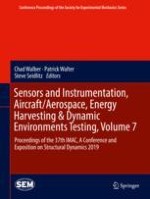2020 | OriginalPaper | Buchkapitel
12. Accumulated Lifetimes in Single-Axis Vibration Testing
verfasst von : Adam Bouma, Abigail Campbell, Thomas Roberts, Stuart Taylor, Colin Haynes, Dustin Harvey
Erschienen in: Sensors and Instrumentation, Aircraft/Aerospace, Energy Harvesting & Dynamic Environments Testing, Volume 7
Aktivieren Sie unsere intelligente Suche, um passende Fachinhalte oder Patente zu finden.
Wählen Sie Textabschnitte aus um mit Künstlicher Intelligenz passenden Patente zu finden. powered by
Markieren Sie Textabschnitte, um KI-gestützt weitere passende Inhalte zu finden. powered by
